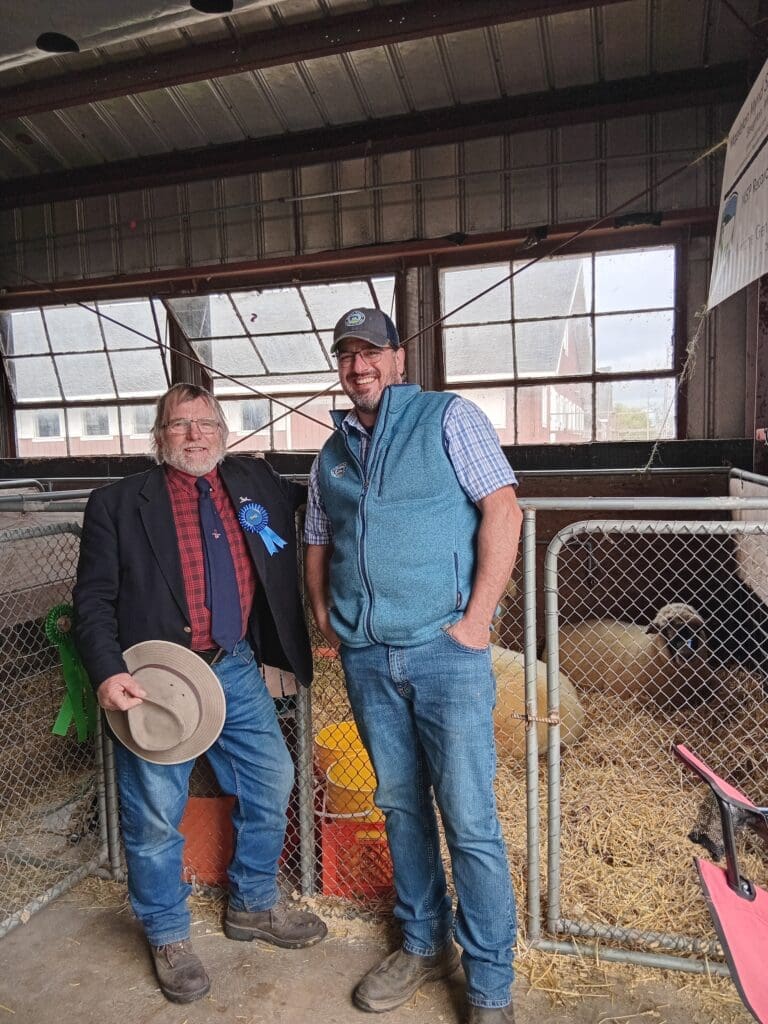Our Board Member for the English Central region had the honour of travelling to the USA to serve as a judge at the inaugural North American Hill Sheep Show, proudly representing our organisation on the international stage.
Can you share a bit about your background and how you’re involved in the wool industry?
I’m a fourth-generation farmer, with the fifth and sixth generations already following in our footsteps. Like many of my generation, my introduction to sheep came early—on a medium-sized Midlands farm with a bit of everything. One of my first jobs, at around age four, was to bottle-feed the lambs.
In the early 1970s, I studied Agriculture at Reading University, where my interest in sheep really took hold. I was fascinated by the new and emerging breeds and crossbreeds, names like ABRO Damline and Colbred (now gone), and Finn, Friesland, Cambridge, and Meatlinc, the latter developed by Henry Fell and now successfully continued by his son and grandson, George. It was an exciting time, though my focus back then had to remain on our dairy herd rather than sheep.
That changed in 2009 when the dairy herd left the farm, giving me time to direct my energy toward new interests. Sheep replaced cows, and as I began reading the annual publications from British Wool, I noticed there was no Derbyshire County representative at the Central Region. One thing led to another, I became Chairman of the Central Region and, much to my surprise, am now a Board Member. Having seen first-hand the consequences of the Milk Marketing Board’s demise, I’m determined to support British Wool and protect our industry from a similar fate.
What inspired your trip to the USA, and what were your main goals for going?
The trip to the USA wasn’t planned at all. Through organising local Sheep Fairs to promote the sheep industry in all its forms, I met an excellent Cheviot breeder, James Metcalf, who had been invited to judge at the inaugural North American Hill Sheep Show in 2024. Their aim is to breed British-type sheep, and for the 2025 show, they were looking for a judge for the “Any Other British Breed” category.
The invitation came as a complete surprise. I accepted with both excitement and a fair amount of trepidation, but with a firm resolve to judge by UK standards.
How would you describe your experience while you were in the USA?
We the four judges invited were treated with extraordinary hospitality, truly “like royalty.” One evening, around 10 p.m., while walking back to our condo, we passed a members’ club and were invited in by two men, one of whom turned out to be the mayor of Escanaba. He insisted that drinks were on his tab all night!
That level of generosity and kindness continued throughout the week. We always had a car and driver available, often from one of the large local families. Many families in the area live simply, no TV, no mobile phones until the children are working and with an average of around ten children, all homeschooled. It was inspiring to see so many polite, hardworking, and confident young people who were eager to talk and engage.
Escanaba, on the northwest coast of Lake Michigan, is a rural area with modest farms and strong support for Donald Trump. The sheep we judged over three days were, with very few exceptions, of a remarkably high standard, many would have held their own against serious competition in the UK.
There are about five million sheep in the USA, but lamb and mutton remain unpopular. The story goes that during the world wars, American troops stationed in the UK were fed poorly cooked mutton, and that bad experience still lingers. Attendees travelled anywhere from 3 to 48 hours to reach the show, which had a wonderfully social, friendly atmosphere quite different from most shows in the States.
What key takeaways or positives did you bring back from the trip?
Wool, for many in the USA, is something of an embarrassment. Many exhibitors process their own wool at home, it’s a small-scale, cottage-style industry, often run by family members. Despite that, the quality of the yarns and the natural dyes they produce were impressive.
There’s real potential for a gradual introduction of British genetics to help improve carcass quality in American flocks. Thanks to John Royle of the NFU, I’m now in regular contact with John Wilkes of AHDB in the USA and have reconnected with Cody Heinke, one of the key figures driving progress in their sheep sector.
How do you see your experience influencing your work in the wool industry moving forward?
The biggest takeaway for me, as a Board Member, was the reminder of how fortunate we are in the UK to have a functioning auction system, where buyers actively compete for our wool, recognising its quality. As Cody said, rather ruefully, in the US much of their wool is simply “left in a corner until I can find a use for it.”
That contrast has strengthened my resolve to continue standing up for and promoting British Wool. We have an incredible product and a system worth protecting.




